Should I Continue to Workout With Shoulder Bursitis
Shoulder Bursitis can be frustrating and painful. BUT, with the right shoulder bursitis exercises, shown in this article, you can get your shoulder to a 100%, without the need for cortisone injections or surgery.
In this post, we will outline:
- What shoulder Bursitis is
- What the causes are
- Treatment options and their effectiveness
- The best shoulder exercises to fix it
What is Shoulder Bursitis
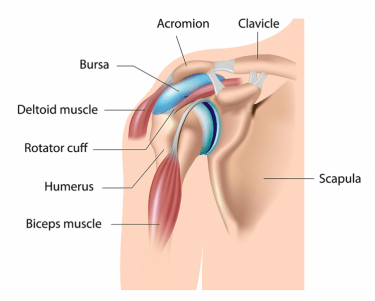 Shoulder bursitis is technically called subacromial bursitis and is inflammation of the bursa in the shoulder. To understand what it is, you, first, need to know some basic anatomy;
Shoulder bursitis is technically called subacromial bursitis and is inflammation of the bursa in the shoulder. To understand what it is, you, first, need to know some basic anatomy;
What is a Shoulder Bursa
A Bursa is a very thin (1-2mm) fluid-filled sac and they are found throughout the body. They help decrease friction and ensure different tissues move smoothly.
The subacromial bursa is, as the name suggests, under the acromion. It separates and creates smooth motion between your top rotator cuff muscle and your acromion bone.
The acromion is the uppermost aspect of your shoulder blade that forms the roof of your shoulder.
Why is it sore
When the bursa gets overloaded through one of the below causes, it becomes inflamed and puffs up. Because there isn't much space in the subacromial space between the roof of the acromion and the shoulder joint, you can then get pain and impingement.
Where should I feel the pain
Pain from shoulder bursitis is often felt to the side of the shoulder and can refer down towards the elbow.

What causes shoulder bursitis
The subacromial bursa gets inflamed typically due to repetitive or sustained load that put load on the bursa. This is normally activities with either your arm out in front of you, over your head or in slouched positions.
Activities, where your arm, is elevated put the bursa in a more compressed position and hence with repetition is more likely to get irritated.
Slouching or having a forward shoulder blade position brings the roof (acromion) down lower, meaning there is less room for error.(1)
What adds to and makes you more likely to get shoulder bursitis is the following:
- A weak rotator cuff or Lats – The cuff help keep the ball sitting in the socket nicely, without this, impingement of the bursa can happen
- An over-active deltoid – This tends to ball the ball up in the subacromial space more
- A tight pec minor and forward shoulder position – this brings the "roof" down
It can also be caused by prolonged compression such as sleeping in one position on your side for a long time or abnormalities of the acromion such as osteoarthritis or a beaked acromion.
So, hopefully, you are beginning to see that bursitis is generally secondary to other issues. If we address everything around it such as muscle length and strength, the bursa has a chance to settle and get better.
Treatment options
Cortisone injections
These are done very often but with high rates of recurrence of pain. This is partly due to the fact that you are just band-aiding, covering and easing the pain.
The trouble with this is that if there is any underlying causative weakness, stiffness or poor control, the shoulder bursitis or shoulder pain is likely to come back without good rehab to address deficits.
As well as that, the available literature indicates that there is little reproducible evidence to support the efficacy of subacromial corticosteroid injection in managing rotator cuff pain.(1)
Surgery
Surgery should be the last option. There is no evidence that surgery is more effective than conservative treatment. (2)
Shoulder bursitis, often called subacromial bursitis is largely a secondary issue. That means that is caused by something else and doesn't often just happen by itself.
That, simply, is why surgery isn't the be all and end all and why there is a lot of studies (below) that show that surgery is no better than exercise rehab for impingement syndrome (which causes shoulder bursitis) and large rotator cuff tears.
Physiotherapy rehab shoulder bursitis exercises
In my view, no one should try a cortisone injection, let alone even think about an operation until they have done 12 weeks of effective and regular exercise rehab.
Don't try it for two or four weeks and give up – muscles and tendons simply don't adapt fast enough to make a significant change in that time typically.
Load the muscles and tendons and they will adapt, addressing the issue behind your bursitis (most likely) and taking the load off the bursa, allowing your shoulder pain to settle naturally.
So, in light of that, here are our favorite rehab exercises (and most shoulder pathologies actually!) that are easy to do from home:
1. Lat pull-down
Using a Power Band or cable machine, this is a great exercise which strengthens your Lats. Your Lats help hold the ball down so it doesn't rise up into the subacromial space and pinch your bursa.
Do 3 sets (lots) of 10-15 but with all these exercises 1-5, it is best to take the muscle to fatigue.
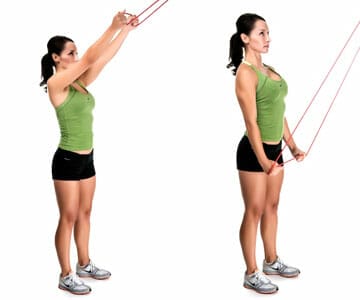
2. Rotator cuff external rotations
Lie on your side with your elbow touching your side and at a right angle as shown. rotate your fist up, keeping your elbow at 90 degrees and in your side and then lower down again.
Find the weight where your tire out at about 10 reps (often 1/2 or 1 kg is enough to start with) and do 3 sets to fatigue (10-15)
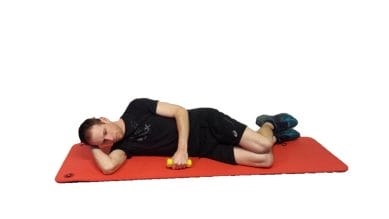
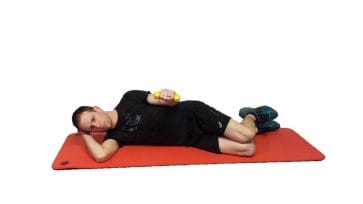
3. The Arnie press
*If this or any of the other exercises are sore to do. Don't do it yet, work on the ones you can do.
Start with a weight that makes your muscles tire at about 10 reps (this could be 1kg, a drink bottle or even 5kg).
Your hand should be in front of your shoulder and knuckles forward. Press upwards, while rotation through range so that your knuckles are backwards and then go back down to the start position, rotation through the range again as shown.
To 3 sets to fatigue (3 sets of 10-15 reps usually, otherwise adjust the weight)
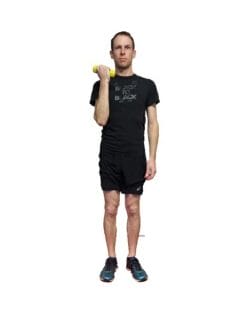

4. Flys
You can do this shoulder and scapula strengthening exercise in standing with a resistance band OR lying on your front on a bench with weights in your hands.
Find the resistance or weight where you fatigue at about 10 reps and do 3 sets of 10
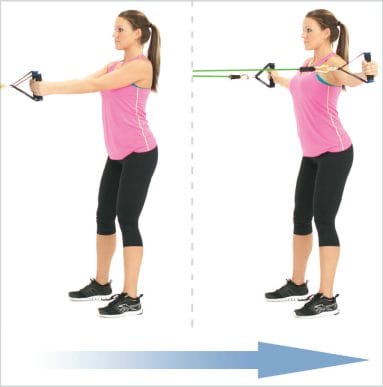
5. One arm wall push-ups
This is a great one for getting global strength and control of the shoulder girdle and for a lot of people with shoulder bursitis, is pain-free to do.
Place your hand in front of your shoulder (you don't want it too high) and do a push-up, looking to keep your shoulders level and not tilting into the wall with your opposite side.
Adjust the distance your feet are out from the wall to make it challenging but do-able.
Do 3 sets of 10
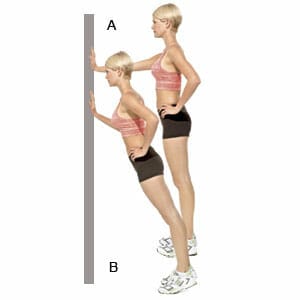
6. Posterior cuff stretch
A lot of people with shoulder pain and bursitis lose the ability to put their hand behind their back comfortably and this tends to pull your shoulder blade forward. address this by stretching out the back of the shoulder joint as shown. Make sure to pull shoulder arm into your chest rather than in the across your body.
Hold for one minute. It shoulder stretch the back of your shoulder/arm, if it pinches on top of in the front, you aren't ready for it yet.

To help get rid of shoulder bursitis, do all these exercises once a day, 5 days per week for 12 weeks and as they get easier – make them harder.
Source: https://www.physioprescription.com/shoulder-bursitis-exercises/
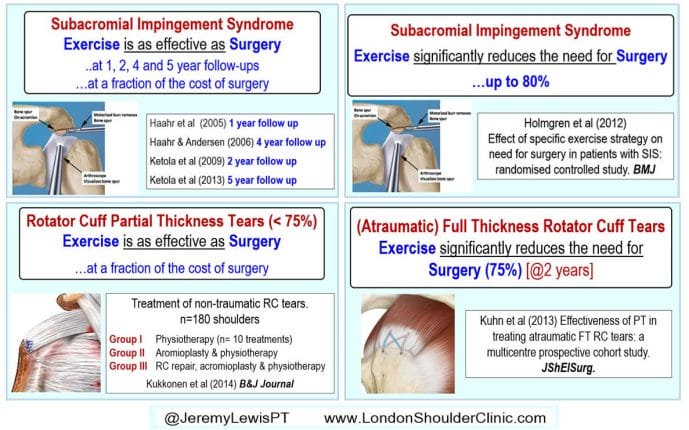
0 Response to "Should I Continue to Workout With Shoulder Bursitis"
Postar um comentário